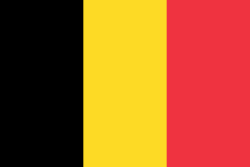 Flag of the German Empire (Reichsflagge)
Flag of the German Empire (Reichsflagge)- Flag of Belgium (civil)
 | |
| Use | National flag |
|---|---|
| Proportion | 2:3 [a] |
| Adopted | 31 December 2001 |
| Design | A horizontal tricolour of blue, yellow, and green in a 2:1:1 ratio, charged with a golden sun in the upper fly |
| Designed by | Alphonse Kirimobenecyo |
The national flag of Rwanda is a horizontal tricolour of light blue, yellow, and green, in a 2:1:1 ratio, charged with a golden sun in the upper fly-side corner. It was adopted on 31 December 2001 and replaced the flag adopted shortly before independence. The design of the flag is defined in the Rwandan constitution and regulations regarding the use and manufacture of the flag are outlined in the country's national flag law (law no. 34/2008, and subsequent amendments).
Contents
- Design and symbolism
- Construction
- Protocol
- Display and handling
- Prohibition of use and desecration
- History
- Colonial era
- 1961–2001 flag
- Adoption of the current flag
- See also
- Notes
- References
- Citations
- Sources
- External links
Rwanda adopted a vertical tricolour of red, yellow, and green following the coup of Gitarama on 28 January 1961, which saw the abolition of the Tutsi-dominated monarchy and the establishment of a Hutu-dominated republic. A black "R" was later added to the flag's centre in September 1961. The government of the Tutsi-led Rwandan Patriotic Front (RPF), which in 1994 overthrew the Hutu-led government and ended the Rwandan genocide, announced in 1999 its intention to change the national flag, arguing that the existing flag had become associated with the genocide. Critics viewed the move as an attempt by the RPF to symbolically assert its rule.







